Detailed and thoughtful schedule of the Palio day.
In Siena, on the day of the Palio, the day is marked by precise moments that culminate in the horse race, the ‘carriera,’ which takes place in Piazza del Campo every year on the evening of July 2nd and August 16th.
The ‘machine’ of the Palio, to which the Contrade and the Municipality of Siena dedicate themselves throughout the year, showcases its full ‘majesty’ (quote) on the day of the race.
What specifically happens on the day of the Palio in Siena?
You wake up with your heart in your throat, knowing that the rhythm of the day will be marked by the word ‘anticipation’.
Before continuing, a clarification: unless otherwise specified, tourists can attend every scheduled event on Palio day, remembering to maintain a curious yet respectful attitude.

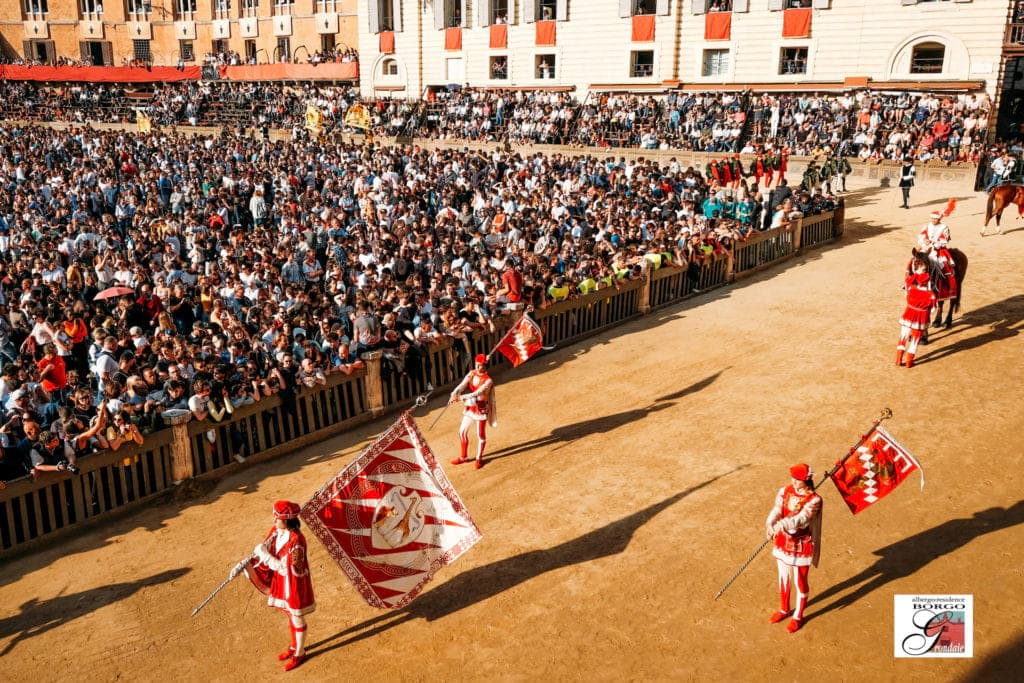
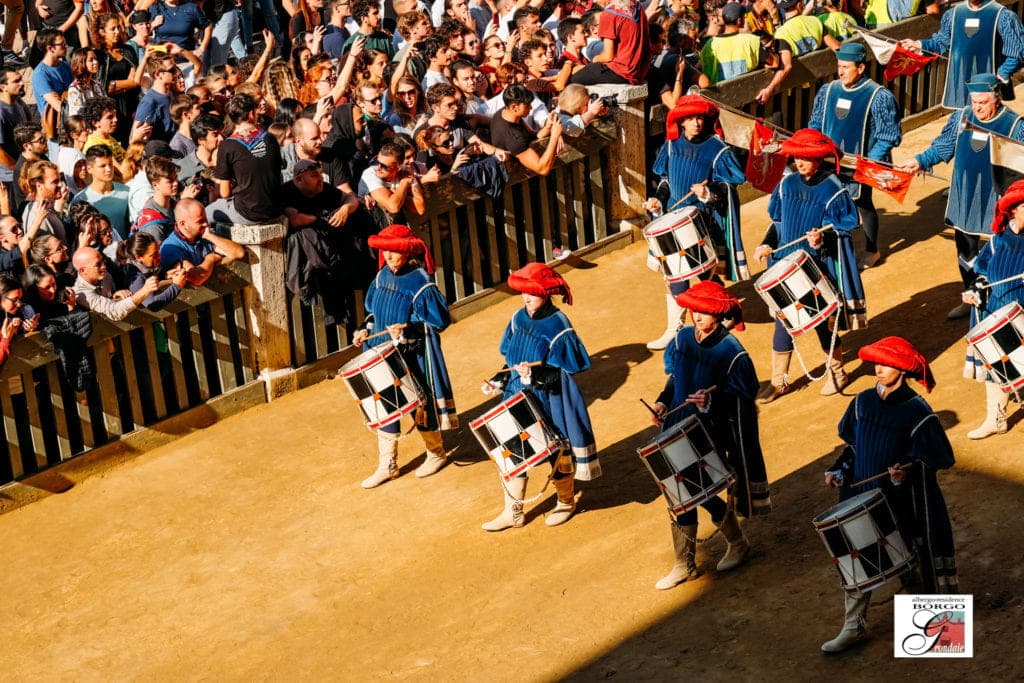
That said, here’s what happens in Siena on Palio day.
Jockey Mass: 7:45 AM
Early in the morning, the Archbishop of Siena celebrates the Mass for the ten jockeys who will race in the Palio at the Chapel in Piazza del Campo. This ceremony is part of the propitiatory rituals, as, despite the jockeys’ expertise, they are still at the mercy of “Lady Luck” during the race. It’s worth mentioning that the jockeys race “a pelo,” meaning without a saddle, in the Siena Palio.
Provaccia: 9:00 AM
Immediately after the Jockey Mass, the final trial of the Palio, called ‘provaccia,’ takes place in Piazza del Campo, as the final decisions are already made. The clearing of the square begins at 8:40, so we recommend entering earlier.
Jockey Drawing: 10:00 AM
After the provaccia, the jockey drawing takes place in the Palazzo Comunale, where each jockey is officially assigned to a Contrada, as agreed between the parties. Until this moment, the Contrada could still change jockeys, but from this point on, it is no longer possible. This formal ceremony is not open to tourists. You’ll find yourselves trying to pass the time, as the day will seem to stretch on. To distract yourself, we suggest having a first or second breakfast in Piazza del Campo, and perhaps visiting the Palazzo Pubblico with its wonderful museum.

Dressing of the Members of Each Contrada: Varies from Contrada to Contrada. Typically from 1:00 PM
In the Contrada, in the early afternoon, the dressing of the members begins. These lucky Contradaioli are chosen to enter the Piazza “dressed” in their Contrada’s colors and are part of the historical procession that tells the story of Siena, going backward from the fall of the Republic in 1555 to its most glorious moment: the Battle of Montaperti, won against the Florentines in 1260. (Monturato is a typical Sienese word meaning “someone who wears the precious costumes inspired by the Renaissance).
Blessing of the Horse: Varies from Contrada to Contrada. Typically from 2:00 PM
The blessing of the horse usually takes place inside the Contrada’s Oratory. In some cases, when access to the Oratory is difficult (for example, the stairs leading to the Oratory of the Drago) or when the horse shows signs of restlessness, it is performed outside. If the blessing takes place inside the Oratory, our advice is to leave this moment to the few Contradaioli who will have the privilege of attending. If it is performed outside, you may watch, but please follow the only instruction given: remain silent during the short ceremony, in which the ‘correttore’ (the priest of the Contrada) will bless the jockey and the horse and encourage them to go and return victorious. Silence must be maintained during the ceremony, and even after it ends, which means no applause, as it might be instinctive, until the horse has been led away to avoid frightening it.
Departure of the Processions to the Palazzo del Governo in Piazza Duomo
After the blessing of the horse, the procession from each Contrada departs for Piazza Duomo. Each procession consists of: a drummer between two flag bearers, a duce (leader) between two armed men, and the senior page between two standard-bearer pages. Before the historical procession enters Piazza del Campo, it will be joined by the fatino (a young rider in parade gear on the “soprallasso” horse, used only for the historical walk) with the palfreniere (groom), the barbero (the horse that the Contrada will race with), and the barbaresco (the assistant to the horse during the days of the Palio).

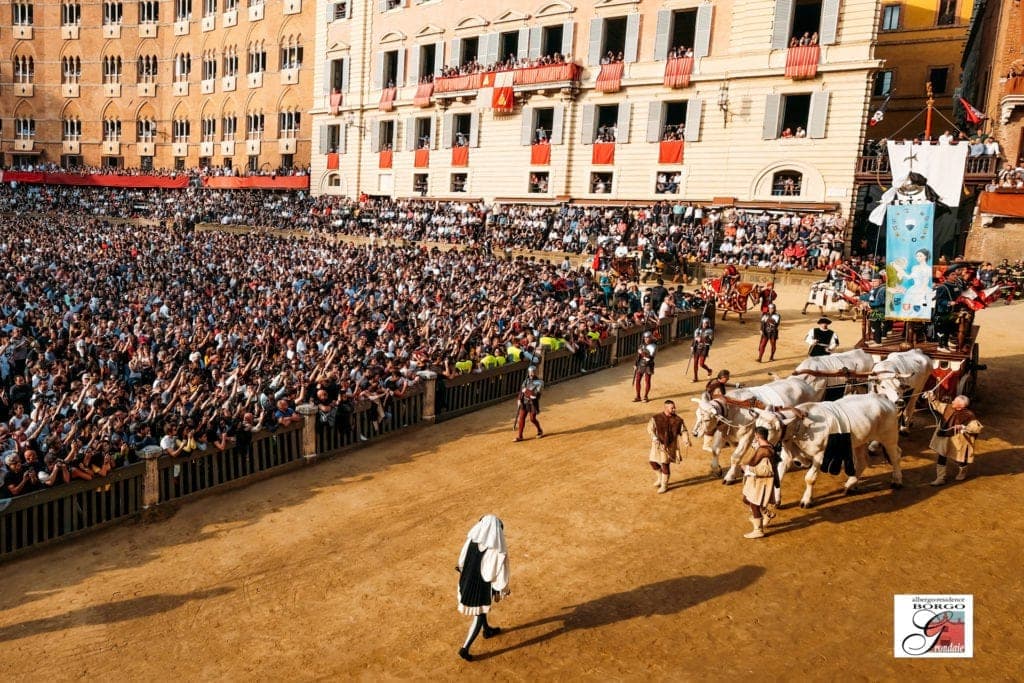
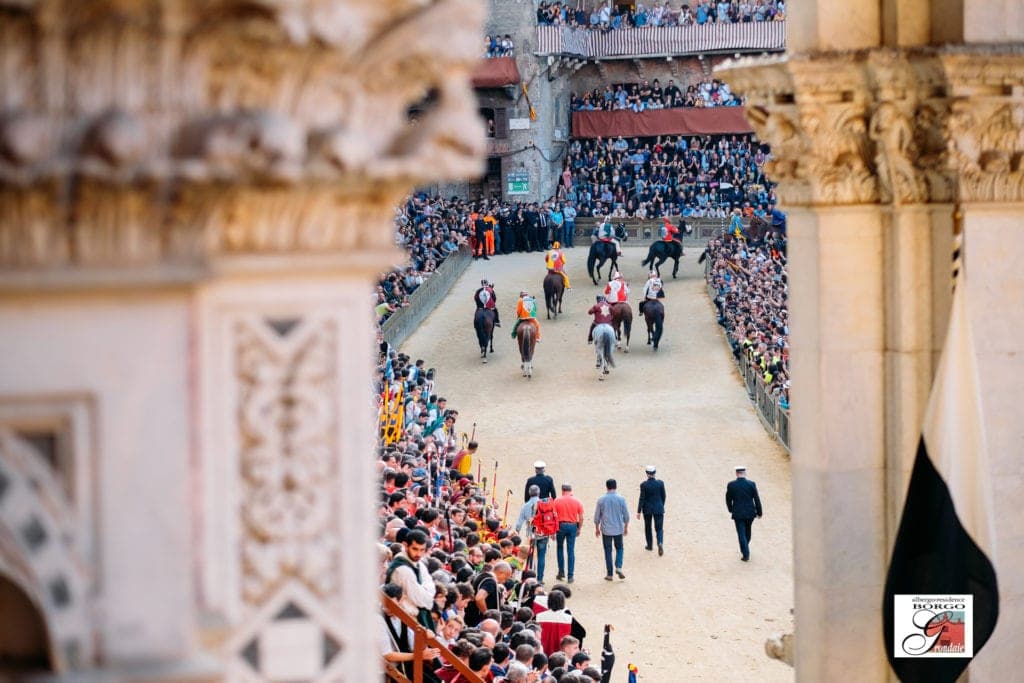


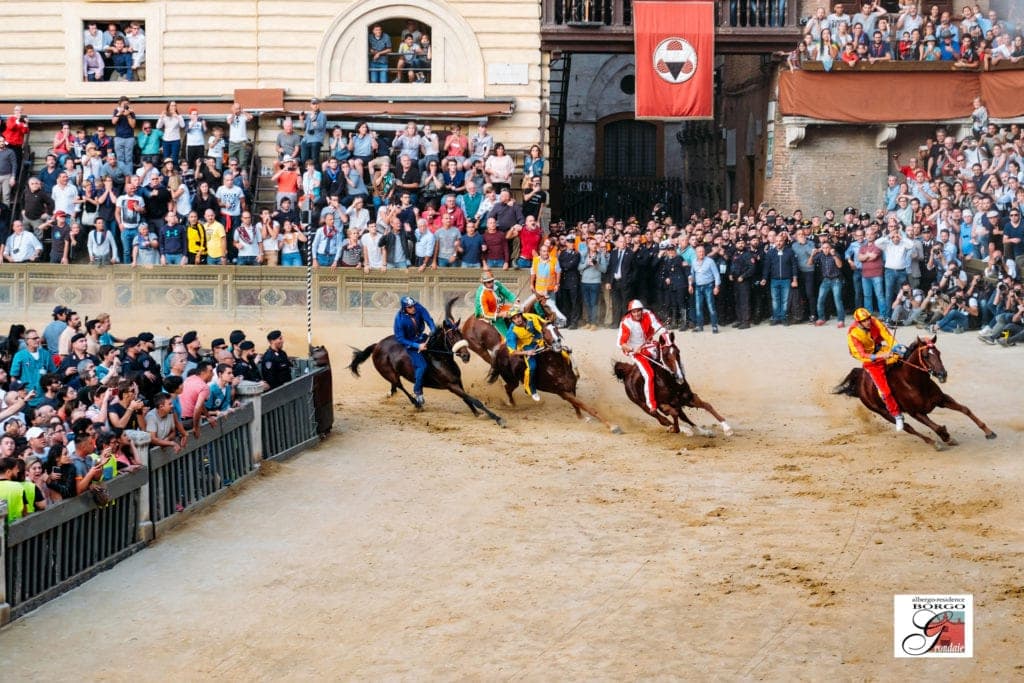
Departure of the Historical Procession from the Palazzo del Governo: 4:30 PM in July (3:50 PM in August)
After the blessing of the horse, go to Piazza Duomo and stop in front of the Palazzo del Governo, from where the historical procession will pass. Here, you will be able to see up close the beautiful costumes of all the participants, including those of the Municipality, for a total of 600 people. Once they have all passed, head towards Via Duprè, the only entrance to Piazza del Campo that remains open until 6:15 PM in July (5:50 PM in August). There are restrictions to be followed, which we will communicate to you at Borgo Grondaie.
Where can the Palio be watched from?
The view from Piazza del Campo is limited, but everyone can see a part of it, believe me, thanks to the unique shell-shaped layout of the square. The atmosphere there is incredible, truly.
If, instead, you have decided in advance to watch the Palio from the balconies, terraces, or windows, the person who sold you the ticket will inform you of the latest time you can access your spot. In this case, we can also help by providing you with our contacts for Palio tickets.
Entrance of the Historical Procession in Piazza del Campo: 5:20 PM in July (4:50 PM in August)
The entrance of the historical procession into Piazza del Campo is announced by Sunto, the bell of the Torre del Mangia, named after the Assumption, which will mark the procession’s timing. For the Sienese, a shiver runs down their spine when they hear the first toll.
Exit of the Horses from the Entrone: 7:30 PM in July (7:00 PM in August)
At the end of the historical procession, there is the flag-waving display in front of the Palazzo Pubblico by the flag bearers of each of the seventeen Contrade, accompanied by a drummer. From this moment, a grave silence falls over the Piazza: the Palio of Siena begins.
From the moment the horses exit the Entrone and reach the ‘mossa’ (the starting line), the tension rises to tangible levels. We recommend observing every detail without asking questions or making comments, jokes, or comparisons. Suddenly, an eerie silence will naturally fall over Piazza del Campo while waiting for the “mossiere” (the official who organizes the race) to receive the envelope containing the starting order of the horses. You will see the eyes of the Contradaioli all focused on the judges’ stage, waiting to spot the police officer who has been entrusted with the envelope, descending the stairs with their arm raised, clearly displaying the white envelope for the mossiere.
At that point, the mossiere opens the envelope and begins calling the Contrade in the order that fate has assigned to each Contrada for the Palio. The most coveted positions are the first ones, particularly the fourth and fifth positions, according to some experienced jockeys. The feared position is the “rincorsa” (the chase), because, as you’ll see, the “rincorsa” starts behind the others, putting it in a clearly disadvantageous position. However, it is the one that decides when to start the race. The mossiere, who is there specifically for this, will lower the canape (the rope that marks the starting line) to begin the race as soon as he notices the right moment.
It could last ten minutes, a quarter of an hour, or even an hour. Everything will depend on the secret agreements made between the Contrade in the days leading up to the race, and many of those made by the jockeys just before the start.
End of the Race
And after the race, what happens?
Well, after the race, the advice is to stay where you are for a moment, because there will be many people trying to leave immediately. Then, follow the exit from the square and head towards the Basilica of Provenzano in July (towards the Duomo in August), where the victorious Contrada, with the Palio won (the drappellone), the jockey, and the horse will go to thank the Madonna by singing the Te Deum.
